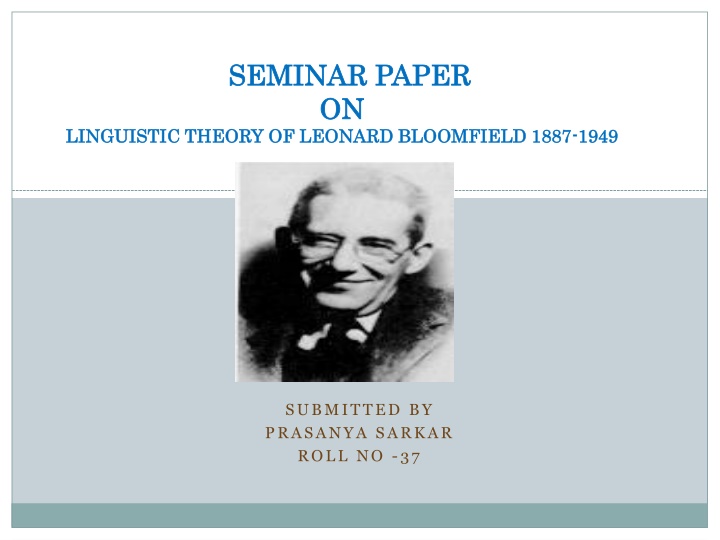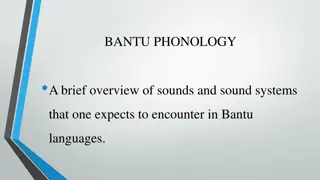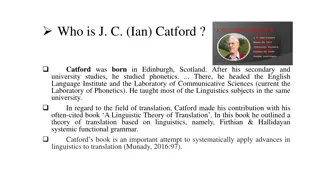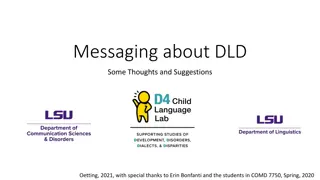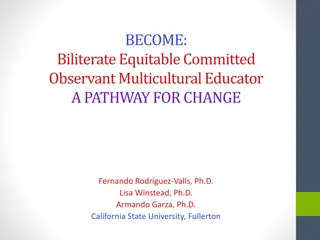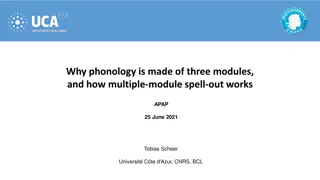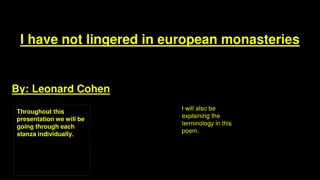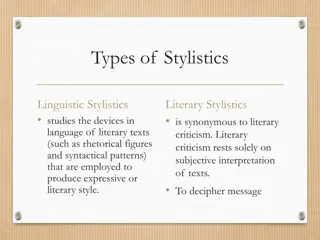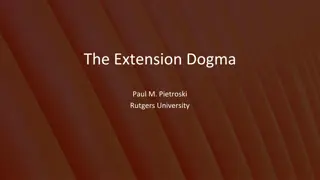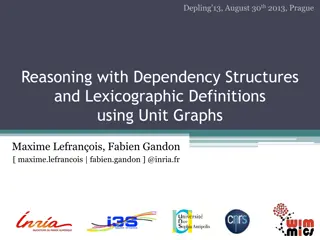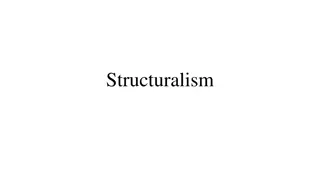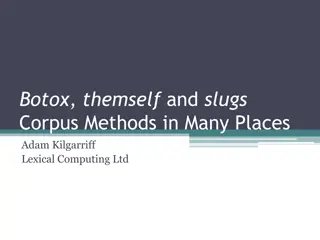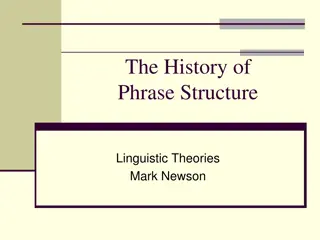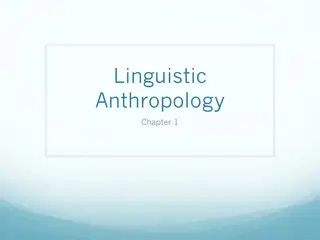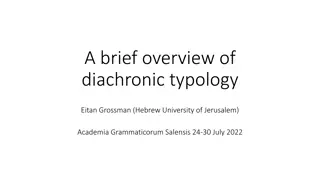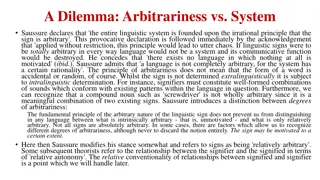Linguistic Theory of Leonard Bloomfield - A Brief Overview
Leonard Bloomfield, a prominent figure in linguistics, made significant contributions to the field with his theories on utterance, speech communities, and behavioral approach to language. His work emphasized the importance of understanding language as a collective system within speech communities. Bloomfield's concepts like phoneme, morpheme, and syntactic constructions continue to influence linguistic studies.
Download Presentation

Please find below an Image/Link to download the presentation.
The content on the website is provided AS IS for your information and personal use only. It may not be sold, licensed, or shared on other websites without obtaining consent from the author.If you encounter any issues during the download, it is possible that the publisher has removed the file from their server.
You are allowed to download the files provided on this website for personal or commercial use, subject to the condition that they are used lawfully. All files are the property of their respective owners.
The content on the website is provided AS IS for your information and personal use only. It may not be sold, licensed, or shared on other websites without obtaining consent from the author.
E N D
Presentation Transcript
SEMINAR PAPER SEMINAR PAPER ON ON LINGUISTIC THEORY OF LEONARD BLOOMFIELD 1887 LINGUISTIC THEORY OF LEONARD BLOOMFIELD 1887- -1949 1949 SUBMITTED BY PRASANYA SARKAR ROLL NO -37
Bloomfield: Academic Career 1909: He completed his doctoral dissertation on Germanic historical linguistics at Chicago University. 1909-1914: He undertook further studies on Indo- European languages at German universities. 1906 - 1914 1914: He turned to larger considerations of language science in An Introduction to Language Study. 1924: He was one of the founding members of the Linguistic Society of America. During this period, he pioneered descriptive studies of one of the Austronesia languages, and began his classic work on North American Indian languages. 1914 - 1933 1933: He published his influential textbook, Language, which became an essential reference for all specialists. 1935: He was President of the Society. 1938- 1941: He taught in the Society s summer Linguistic Institute. 1933- 1949
Central notions of bloomfied theory Utterance Speech community Alikeness of speech community Behaviourist concept of meaning Linguistic form Morpheme Phrase Syntactic construction Phoneme
UTTERANCE : Utterances are produced by acts of speech. An act of speech is an utterance. Example: We imagine a speaker. By making an act of speech, she makes an utterance. So, any kind of act of speech brings out an utterance
Speech community A speech community is a group of people who interact by means of speech and The totality of utterances that can be made in a speech community is the language of that speech- community . Examples, we can think of the group of speakers of English and the group of speakers of German.
Alikeness of speech community According to Bloomfield ,we must assume that in every speech-community some utterances are alike in form and meaning. In order to make sense of Bloomfield's fundamental thesis of alikeness of utterances, which we needs to distinguish groups of speakers (or speech communities). The word `man' spoken on various pitch-schemes is in English
A Behaviourist Approach to Language Jack and Jill s Story Jill is hungry; some of her muscles are contracting and some fluids are secreted. She sees a red apple on a tree(the light waves reflected from the red apple strike her eyes). She asks Jack to fetch the apple for her. Bloomfield's theory of semantics is behavioristic. It is explained in terms of patterns of stimulus and response. to certain stimuli A a person reacts by speaking; his speech B in turn stimulates his hearers to certain reactions C. Hunger= S Speech utterance= r Speech utterance= s Jack fetches the apple= R
Linguistic forms Linguistic forms are different kinds of units of language, like morphemes or words. A form is a recurrent vocal feature which has meaning. Forms are abstract, theoretical concepts. Any word is a form.
Morpheme : A recurrent meaningful form. It is the minimal unit of linguistic meaning. Example watched= 2 morphemes watch + simple past Pens= 2 morphemes pen+ plural Unhelpful=3 morphemes negative+ help+ adjective
Bound/Free Morphemes Morpheme Bound: It can not stand alone (ing- ly- ness) Free: It can stand alone (love, write, play) Prefixes: un-happy ,re- write pre- view Suffixes: writ-ing, quick-ly, Care-ful
: Derivation/ Inflection Bound morphemes can be derivational or inflectional. Derivational morphemes derive new words from other words. e.g., unhappy un + happy; happiness happy + ness Theychange part of speech or the meaning of a word. Inflectional morphemes, on the other hand, do not change meanings or parts of speech, but simply make minor grammatical changes necessary for agreement with other words. e.g., cats cat + s; cooler cool + er There are only eight inflectional morphemes: -s, -ed, -ing, - en, -s, -'s, -er, -est.
Phrases Phrases are used in grammar to distinguish the sub structural parts of Sentences. Phrases can stand alone, like words. Example : The man travelled long.In this sentence the man is noun phrase and also travelled verb phase among other phrase.
Syntactic construction Structure between words in sentences is called syntactic. Syntactic constructions, then, are constructions in which none of the immediate constituents is a bound form. The order may be successive, simultaneous . Example: Ram plays football. S + V + O
Phoneme The phoneme as a minimum unit of distinctive sound- features. Bloomfield considers the phonemes of a language as the only relevant elements to its structure. According to Bloomfield the linguist should proceed by making up a list or table of the phonemes of a language. Example For uttered the word America 4 distinctive sound need. a/me/ri/ca. And also CAT = k /ae/t MAT = m/ ae/ t According to phoneme of a word we divide into syllable.
Conclusion Bloomfield is often regarded as the most prominent American linguist of the first half of the twentieth century. to the study of language emphasized observable phenomena and the spoken language rather than abstract mentalist processes. He interested in form of language not in meaning.
References Majhi, Shambhunath and dr. Birbal Saha: language across the curriculum, page 48 to 54. Sannyal, Shraboni and dr. mukherjee Utpal: language across the curriculum, page-23 to 26. Meier, Thomas, October 2012: A logical Reconstruction of Leonard Bloomfield's Linguistic Theory Bloomfield, L. (1914): An Introduction to the Study of Language, by Leonard Bloomfield. London, G. Bell and sons. Newmeyer, F. J. (1986). Linguistic Theory in America. Orlando, Academic Press. Web References http://ling.yale.edu/history/leonard-bloomfield 11/09/2016, at 8.30 p.m. http://www.slideshare.net/Sichez/leonard-bloomfield,ppt 11/09/2016 at 8.30 p.m. https://en.wikipedia.org/wiki/Leonard_Bloomfield, 11/09/2016, at 8.33 p.m. http://www.slideserve.com/flynn-sweeney/leonard-bloomfield ,ppt 11/09/2016 at 8.30 pm.
